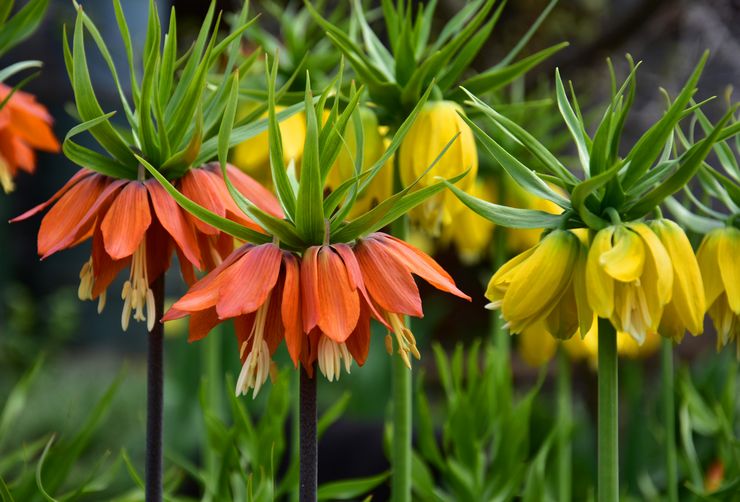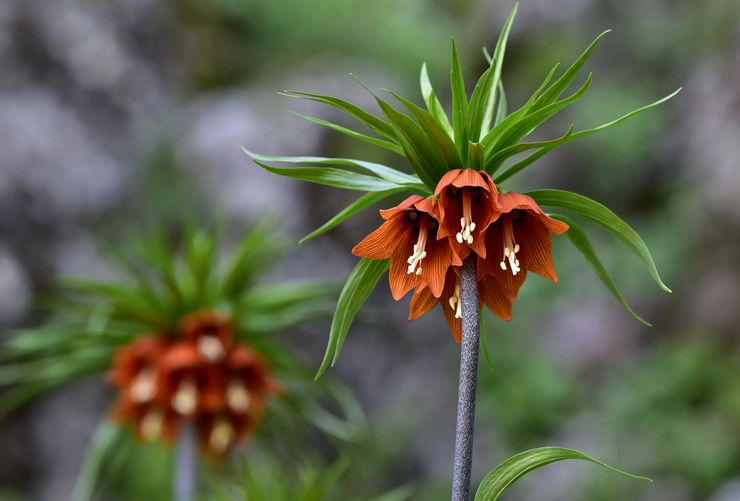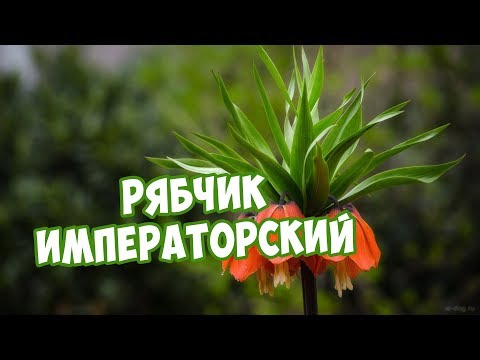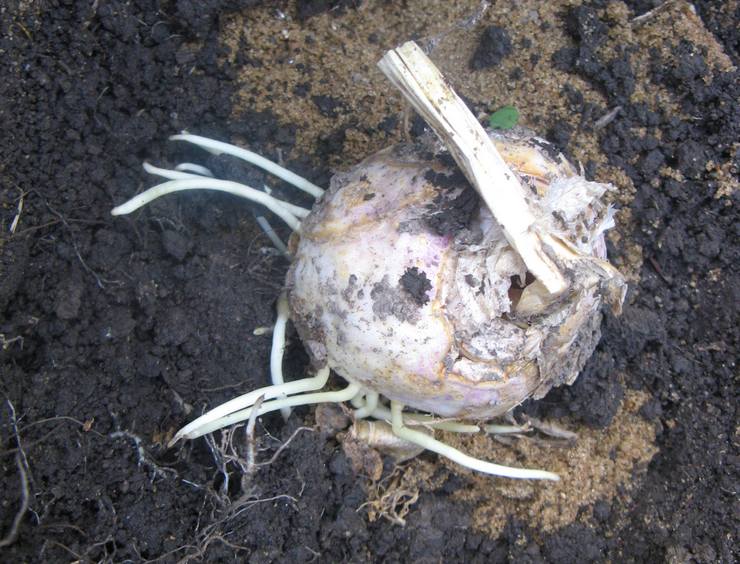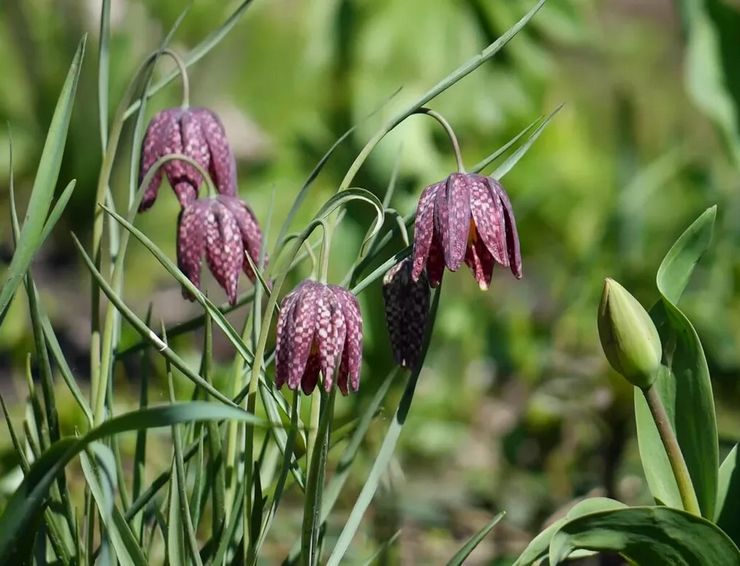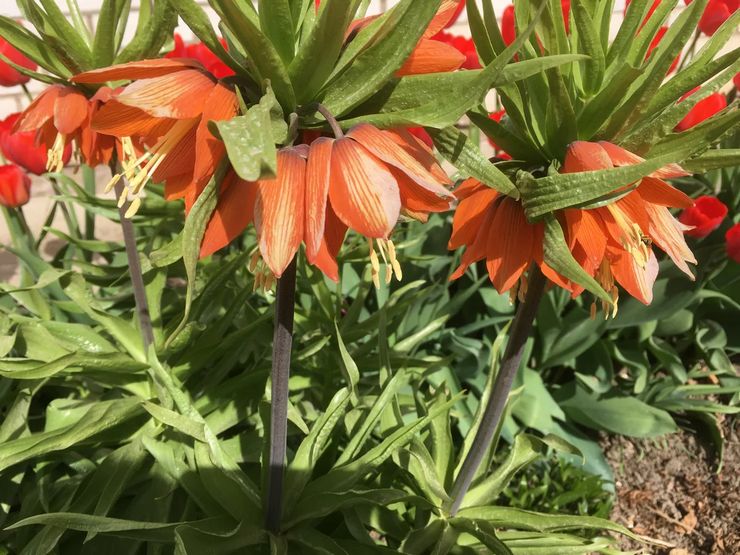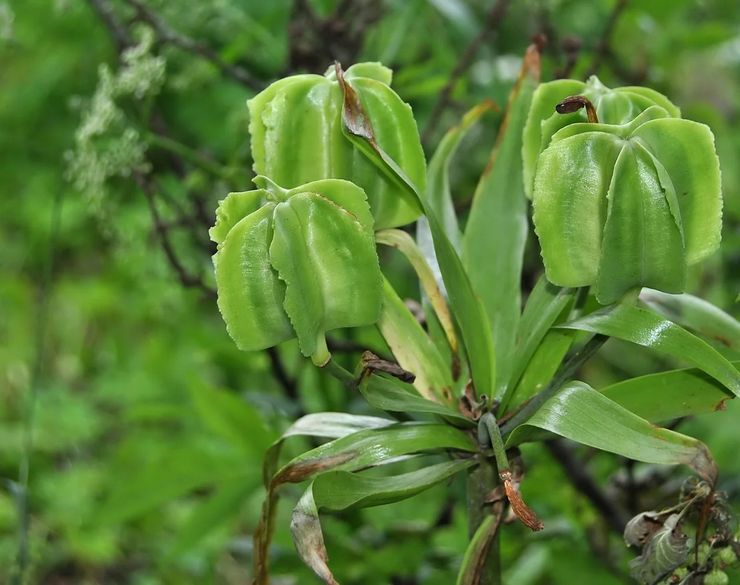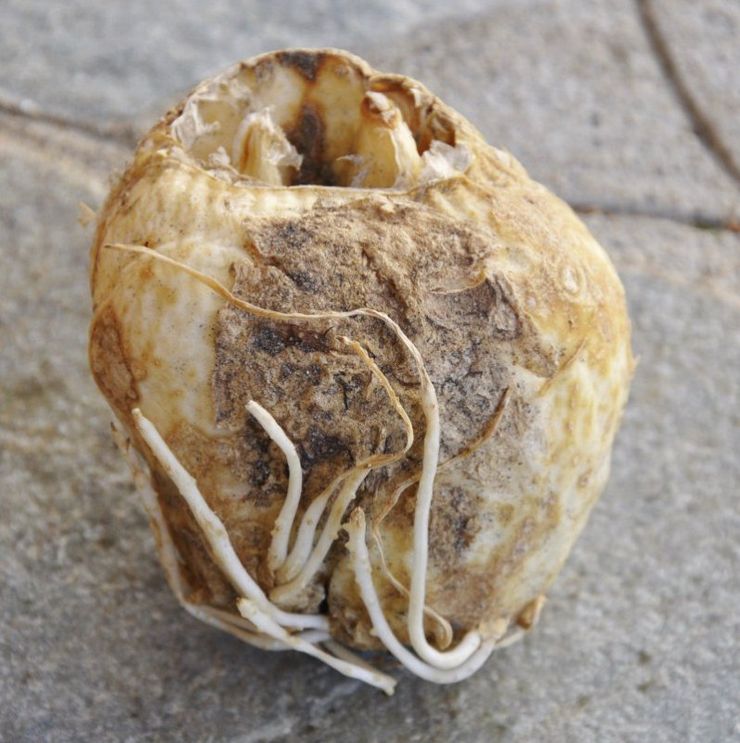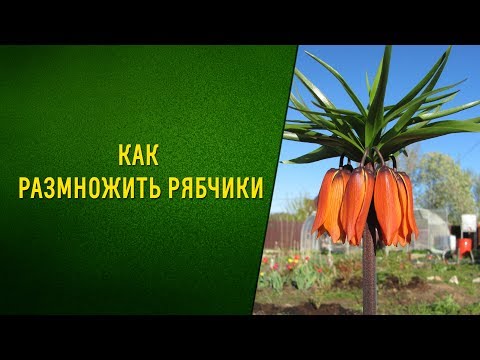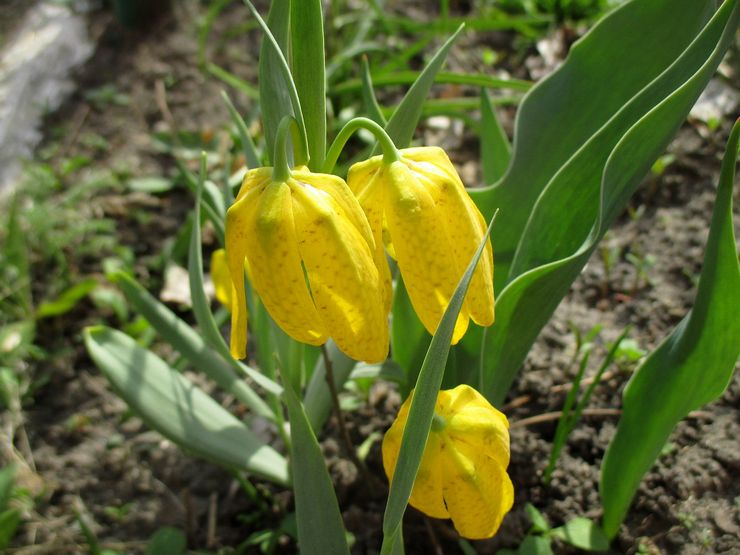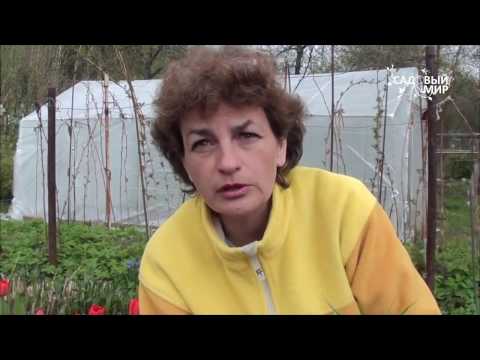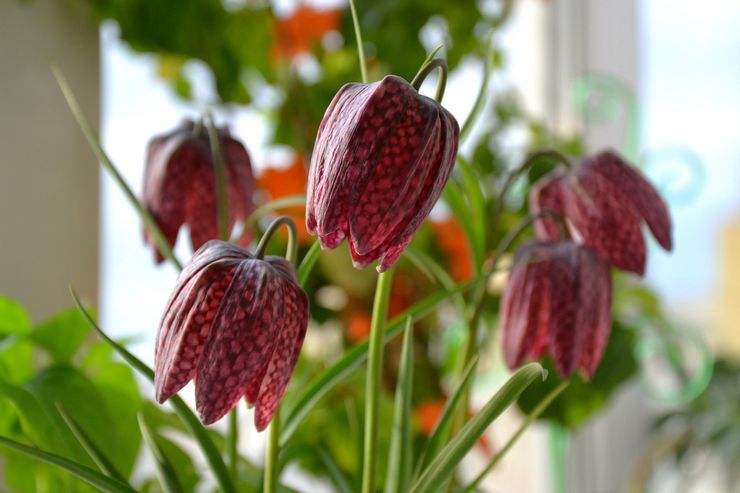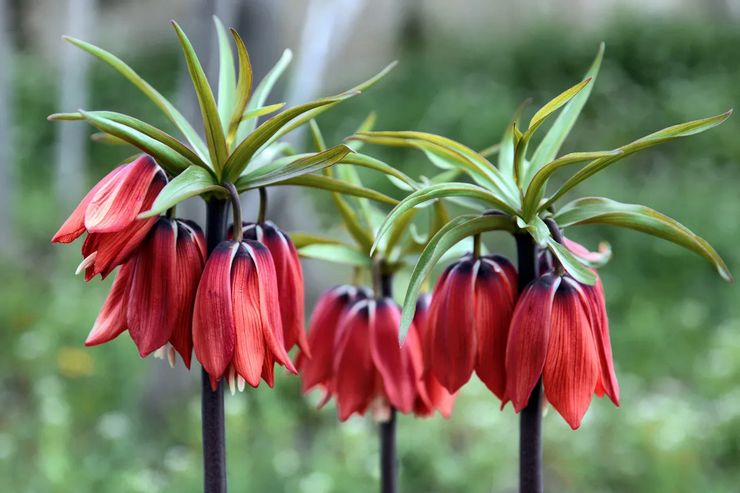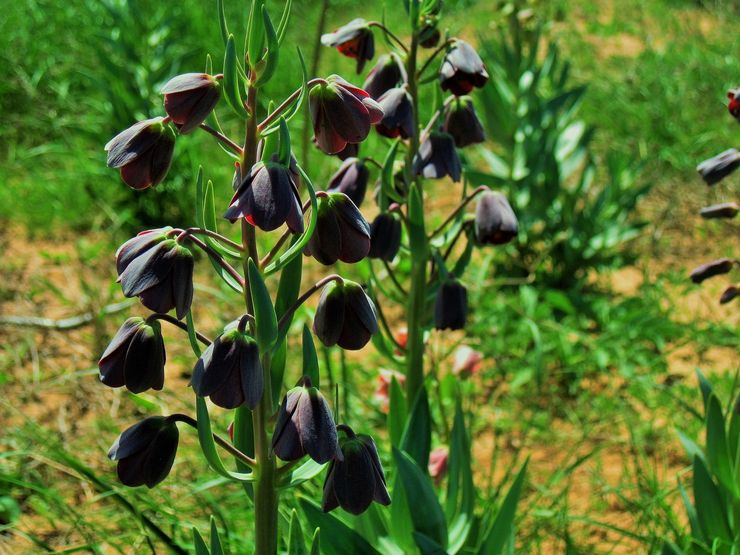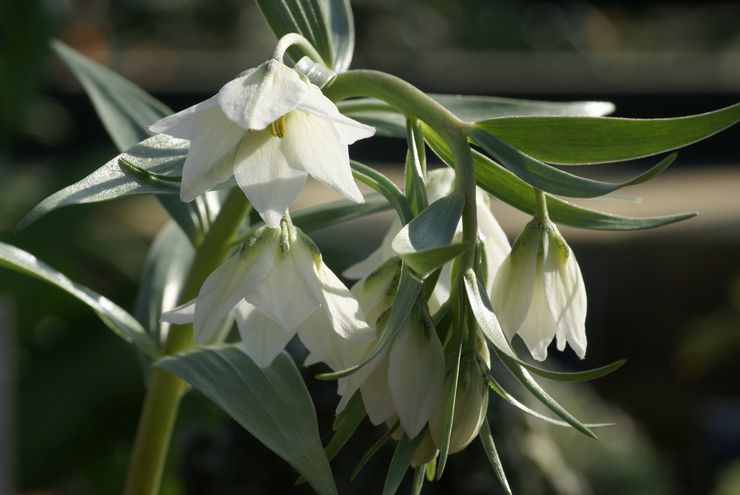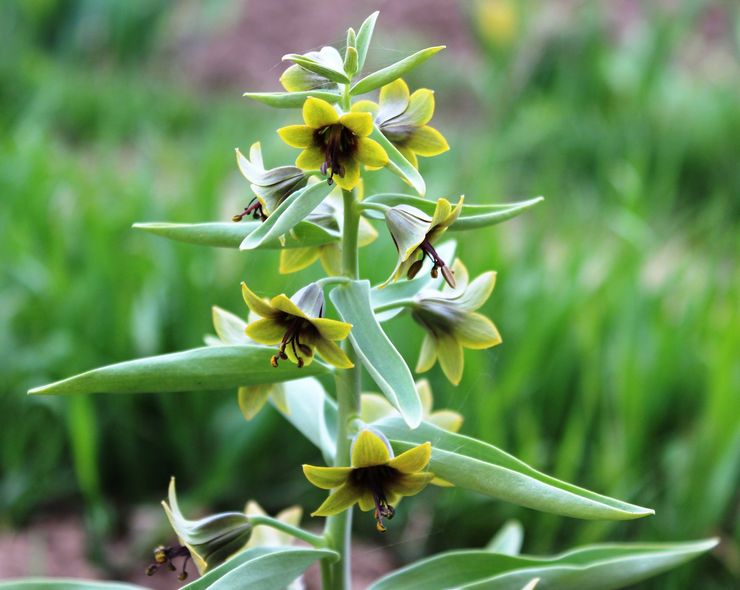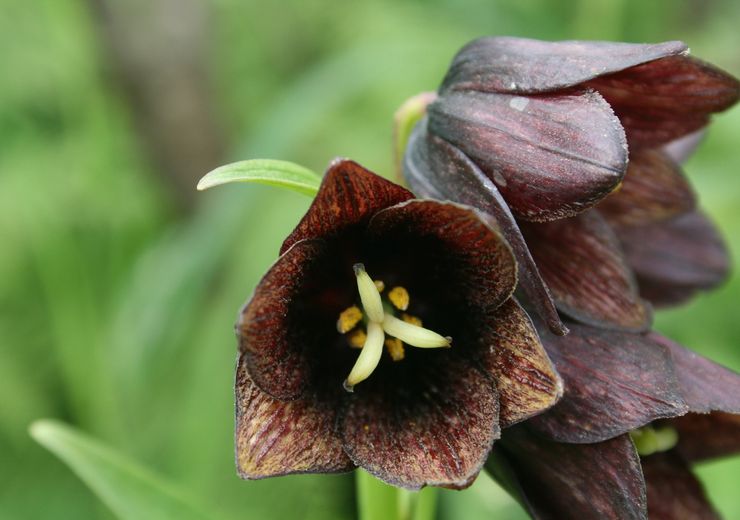The hazel grouse (Fritillaria) is a perennial representative of the Liliaceae family. Its second name – fritillaria, comes from the designation of a chessboard or a glass for dice. This is the shape that the flowers of this perennial have. The more common name “hazel grouse” is also associated with the variegated color of flowers of some of its species..
This genus unites about 150 different species, sometimes significantly differing in appearance. In nature, hazel grouses live in temperate climates, mainly in West and East Asian countries. Many types of flower are considered medicinal plants, and the bulbs of individual hazel grouses have even been eaten.
One of the most frequently cultivated species of hazel grouse is considered to be the imperial one. Although this plant has been used in horticulture for several centuries and is considered not too whimsical, it can be difficult to achieve full flowering. The difficulty of growing an imperial hazel grouse is that sometimes flowers on its shoots do not appear even with proper care.
Description of hazel grouse
Grouse are herbaceous plants that often resemble miniature palms in appearance. Their flowers are located at the top of the palm-shaped shoots. Because of this feature, the bushes are also called “trees of paradise”.
“Palm” of hazel grouse grows from a bulb, collected from dense and wide scales. There is no protective layer on them, so the planting material should be handled as carefully as possible. On the stem of the plant there are many long narrow leaves, sometimes collected in whorls. Hanging flowers can appear singly or form a panicle or umbrella. Their perianths are brightly colored, monochromatic or motley. They can be colored purple, white, yellow or red. After flowering, the hazel grouse forms capsules with a large number of seeds..
Grouse Imperial &# 127802; Planting and Care &# 127802; Tips from the Heatsad
Brief rules for growing hazel grouses
The table shows brief rules for growing hazel grouses in the open field.
| Landing | Planting is usually done in late summer or early fall.. |
| Lighting level | A sunny or slightly shaded place is suitable.. |
| Watering mode | Bushes need timely watering – it is impossible to allow the land to dry out completely. After the end of the growing season, the plants are watered less often – 1-2 times a month.. |
| The soil | The flower will feel best in a nutritious, moist and light neutral soil.. |
| Top dressing | For flowers, several dressings are carried out. The first is performed at the end of April. The second time the planting is fed after the end of flowering. |
| Bloom | Usually, flowering begins when the snow melts from the site.. |
| Digging out | When the aboveground part is completely dry, the bulbs should be dug up. |
| Storage | The storage period begins in July. In this form, the bulbs lie until the end of summer, until they form roots and sprouts.. |
| Reproduction | Dividing the bulb with the help of daughter bulbs by seeds. |
| Pests | Slugs, snails, wireworms. |
| Diseases | Diseases are possible due to improper care of hazel grouses. |
Planting hazel grouses in the open field
The best time to plant
As soon as the period of development of the aerial part of the hazel grouse is over, its bulbs are removed from the soil and stored in a dry and ventilated place. They should be kept there until the roots form on the bulbs. After that, they are again transplanted into the ground. This is usually done in late summer or early autumn..
When folding hazel grouse bulbs for storage, it is worth remembering that without protective scales, they can dry out quickly enough. Because of this feature, you should not buy such flowers in late autumn – in this case, the risk of acquiring a dried out bulb that cannot germinate is too great. You can save unplanned onions by putting them in a bag or container with wet peat and tucking them into the vegetable compartment of the refrigerator.
If you tighten the planting too much and plant the hazel grouse only in October, most likely the next year such plantings will not bloom. Before planting the bulbs in the ground, they should be disinfected. To do this, they are treated with a solution of potassium permanganate, and then sprinkled with crushed coal..
Landing features
The garden bed for planting hazel grouse must be prepared in advance. The soil in which the flowers will grow is dug up, adding peat or humus there. If the soil is too heavy, sand must be added. Additives can also include ash or lime. The reaction of the soil must be neutral.
The average planting depth of hazel grouse in open ground is about 20-25 cm. You can calculate it from the diameter of the bulbs themselves – the distance from the bottom upwards should be 2-3 of its diameter. A distance of about 25 cm should remain between plantings. A thin layer of sand is poured into the finished wells. If the flowers are planted in heavy soil, the sand can be replaced with moistened peat. With timely planting, the long roots of the onions can be shortened – this will contribute to their branching. With a late planting, the existing roots do not touch and are carefully straightened. After that, the hole is sprinkled with earth..
Planting hazel grouses should not be carried out on cold or rainy days. The risk of losing plantings placed in too cool and waterlogged soil is too great.
On the bulbs of hazel grouse, which have already formed peduncles, there is a vertical hole remaining from them. The older the bulb, the larger its size will be. To prevent water from falling into such a hole, the bulbs should not be planted at right angles, but slightly sideways. In addition, you can fill the existing void with sand..
Grouse care in the garden
The hazel grouse is not considered a very demanding plant to care for, but not all growers manage to achieve maximum decorativeness from it, therefore, a number of efforts will be required for full flowering..
Lighting
To grow hazel grouse, you will need a sunny or slightly shaded place. Deep shade for planting will not work. The flower will feel best in a nutritious, moist and light neutral soil. It is important to ensure sufficient drainage before planting..
Watering
During periods of drought, hazel grouses will need timely watering – it is impossible to allow the land in the beds to completely dry out. After the end of the growing season, the plants are watered less often – 1-2 times a month, trying to prevent the bulbs from remaining in the dry ground for too long.
Top dressing
In addition to watering, hazel grouses need dry fertilizers. Several dressings are carried out for them. The first is performed at the end of April. A bucket of humus is introduced into the soil, where 1 tbsp was added. l nitrophoska and the same amount of “Agricola” for flowering species. For 1 sq. m of territory will require about 4.5 kg of humus. It is spread over the soil surface in a layer up to 5 cm thick. The second time the planting is fed after the end of flowering, scattering dry fertilizers on the garden bed. For 1 sq. m will require 1 tbsp. spoon of superphosphate and potassium sulfate. After fertilizing, the garden is watered.
After watering, you can remove the weeds that have grown next to the hazel grouse, but you should not loosen the ground next to the bushes – you can touch the roots of the plants. After planting, cover the soil with wood ash, and then mulch it with a layer of peat or humus about 3 cm thick.
Bloom
Usually hazel grouse begins to bloom when snow melts from the site. The plant forms tall, noticeable peduncles. The flowers are bright yellow or orange and look very elegant. Grouse looks great in combination with any spring flowering plants. As a rule, one full-fledged bulb is capable of forming two peduncles. The species can reproduce with baby bulbs, but they are not formed very much, so planting material can be quite expensive..
Grouse imperial – crowned person
Pruning
When the flowers of the hazel grouse fade, they need to be carefully cut off, and the leaves should not be touched, thanks to them nutrients accumulate in the bulb of the plant. In the fall, it is necessary to cut the stem at the root and mulch the place where the hazel grouse grows.
Shelter for the winter
Before the onset of cold weather, it is recommended to cover the planting – this will insure them against winters with little snow or severe frosts. But in the spring, after the snow melts, the shelter is immediately removed – it can prevent the emergence of seedlings. Most species of hazel grouse tolerate recurrent frosts. Even plants nailed down by frost are able to recover when warm weather returns. But more accurate recommendations for growing hazel grouses depend on the specific variety..
Hazel grouse after flowering
After the end of flowering, hazel grouse greens retain their decorative effect for some period, but by the middle of summer their foliage dies off. When the aboveground part is completely dry, the bulbs should be dug up. Leaving them in the soil during this period is quite dangerous – the planting material can suffer from pest attacks.
The bulbs extracted from the ground are cleaned of dry scales, washed in lukewarm water and kept in a pink solution of potassium permanganate for about half an hour. If the onions are damaged or diseased, they should be cut off. After that, the sections of the cuts are treated with a fungicide, and then sprinkled with wood ash. The treated bulbs are placed in a dry and well-ventilated place where the sections can dry out..
Storing the bulbs
Planting material should be stored in a dry, but not too hot (no more than 30 degrees) place with good ventilation. Usually the beginning of the storage period is in July. In this form, the bulbs lie until the end of summer, until they form roots and sprouts. In order to preserve them, they should be periodically examined, choosing diseased specimens..
Breeding methods for hazel grouses
Usually hazel grouses are propagated using daughter bulbs. Although this plant can form seeds, this method of propagation is usually less frequently used. Flowering in this case will have to wait about 7-8 years, but the resulting flowers will be more adapted to the local environment. The flower stalks with bolls are cut before the bulbs are dug out while still green and kept in water for 1-3 weeks, then ripening the seeds in a dry place. Grouse, whose bulbs are less impressive in size than those of the imperial species, are considered more unpretentious and capable of self-seeding.
The imperial hazel grouse is most often propagated vegetatively. One full-fledged onion is usually divided into two, and rarely forms children. After separation, the daughter onions still have to grow in the beds. Flowering will come only after the babies reach a certain size, and this can take several years. But, despite the slow pace of development of daughter bulbs, this method of reproduction is considered the most reliable..
You can stimulate the bulb to the development of children and artificially. After the summer digging, a small cut with a diameter of about 2 cm is made on the largest and healthiest bulb. In this case, only a sterile instrument must be used. The cut is dried in air, without processing anything. After it dries, the bulb is buried in dry and clean sand, and then stored in a ventilated room. By the beginning of autumn, roots should form. After that, the bulb is treated with a fungicide and transplanted into the ground. In order for the plant to spend all its energy on the development of children, the buds that form should be removed from it. It is necessary to remove such a bulb from the soil very carefully – there is a risk of damaging too small children.
Diseases and pests
The hazel grouses have an unusual property. Their bulbs can scare off rodents as well as moles. For this, plants are often distributed throughout the site, trying to place them not only in flower beds, but also next to fruit trees..
But still hazel grouses can be affected by some pests – slugs, snails, and wireworms. It is recommended to use insecticides or traps immediately after the signs of damage are noticed..
Why does the hazel grouse not bloom
Why are hazel grouses not blooming? Site "Garden world"
If the flowers do not appear on the hazel grouse, there may be several reasons for this:
- Bulbs too small. Small planting material up to 5 cm in diameter continues to grow and does not waste energy on the formation of peduncles.
- Incorrect deepening. If the bulbs are located too close to the soil surface, they will be more affected by any unfavorable conditions, such as rain or frost. In this case, the planting material can rot or freeze over the winter. Excessive deepening will cause the bulb to spend too much energy on germination..
- Incorrectly selected soil. Too light soil in winter will freeze through, and clay soil does not allow water to pass through well, leading to rotting of the bulbs. The planting bed must also have good drainage..
- The landing site has not been changed for a long time. If the bulbs are not dug up, they begin to divide, losing noticeably in volume. Large and medium-sized onions should be dug out immediately after flowering, and planted again in the fall. In this case, they should bloom next spring. The rules of crop rotation should also be observed. You should not constantly plant hazel grouses in their old place or in a corner where other bulbous species grew.
- Preservation of the ovary. After the petals have fallen off, the resulting ovary should be removed. This will help the bulb retain the vigor for flowering in the new season..
- Too wet or cold summers. After flowering, bulbs grown in such conditions must be kept in a warm place until transplanted into the ground..
- Little snow frosty winter. In this case, the hazel grouse bulbs may freeze out. To preserve the planting, you should take care of the shelter in advance. To do this, the bed is covered with a layer of humus or peat 10-20 cm thick.
Types and varieties of hazel grouse with photos and names
Due to the huge number of species of hazel grouse, all these plants are divided into several sections, grouping them by places of growth, flower shape, etc. Each of them contains certain types of fritillaria, some of which are found in gardening especially often.
Section I Eufritillaria
The first section combines Mediterranean, West European and West Asian species. The most famous of them is the hazel grouse. This plant has been used in culture since the 16th century, and its name is associated with its unusual color. Its bushes reach a height of 35 cm. The drooping bell-flowers are located singly, less often in pairs. Their color most often combines purple and brown tones, with dark and light areas forming a checkerboard pattern. Many decorative varieties were obtained on the basis of this hazel grouse. Among them:
- Alba and Aphrodite – varieties with white flowers.
- Artemis – flowers combine purple and greenish color.
- Jupiter – forms large red flowers.
In addition to the chess hazel grouse, this section also includes such species as:
- Mountain – has brownish flowers with a dark speck.
- Yellow – with yellow flowers with a light brown checkerboard pattern.
- Needle-lobed – with burgundy green flowers.
- Caucasian – Red Data Book view with bluish-purple flowers.
- Mikhailovsky – forms burgundy flowers with a yellow border around the edge.
- Checkerboard (or small) – with dark reddish-brown flowers and a weak pattern.
Section II Petilium
The section brings together especially large plants that live in Turkey, Iraq, as well as Turkmenistan and the west of the Himalayas. The most common species in this section is the royal hazel grouse, also known as the imperial or “royal crown”. This Turkish species came to European countries at the end of the 16th century, and today it includes about 20 different forms. The bulbs of such a plant have a specific unpleasant odor, and its stems reach a meter in height. The foliage is arranged in whorls. The drooping flowers are quite large – up to 6 cm in diameter. Their color is bright orange, with a brown speck at the base and the same veins. Above the flowers is the foliage of the plant, giving it a resemblance to a palm tree. Main varieties:
- Aurora – medium-sized bush (up to 60 cm tall), forming red-orange flowers.
- Lutea – variety with golden flowers. The height of the bushes reaches 1 m.The variety Luteya maxima has even higher bushes – up to 1.2 m.
- Sulferino – forms orange flowers with a red mesh pattern.
Other types of this section include:
- Radde – hardy species with light yellow or greenish yellow flowers.
- Edward – significantly similar to the imperial look, but its bulbs do not have an unpleasant odor. The flowers are reddish brown or orange..
Section III Theresia
This group includes only one West Asian species – Persian hazel grouse. Its flowers have a deep purple, almost black color. There are other forms of this type, differing in cream, light green, brown or variegated color of flowers..
Section IV Rhinopetalum
It combines species that live in Afghanistan, as well as in western China. Plants are distinguished by an unusual arrangement of flowers for hazel grouse: they are directed to the sides, and not down. Their perianths are thinner and slightly transparent, and their predominant color is monochromatic.
The section includes Bukhara (white-flowered) hazel grouse, as well as several species with pink-lilac or pale pink flowers (Arian, Bukhara, Karelin).
Section V Korolkowia
The group includes only one species – Severtsov’s hazel grouse. This endemic is found only in Central Asian countries. The color of its flowers combines the tones of yellow and brown..
Section VI Liliarhyza
The section includes North American species with flowers that resemble small lilies. Among them is the gray hazel grouse. It forms miniature bushes up to 15 cm tall. The oblong flowers are golden yellow in color, and the inner part is decorated with small brown specks. In Europe, such a plant is cultivated only as a greenhouse.
The hazel grouse is also quite common. Among its varieties:
- Wayne Roderick – Chinese variety. The flowers are iridescent in color, combining tones of brown and emerald colors, the upper part is painted green, and reddish or dark spots are located on the surface.
- Limelight – bushes reach a height of 60 cm.The flowers are green and decorated with olive specks.
Among others, the section includes two-flowered (with chocolate-greenish flowers) and Kamchatka (with purple or bronze flowers) hazel grouses.

